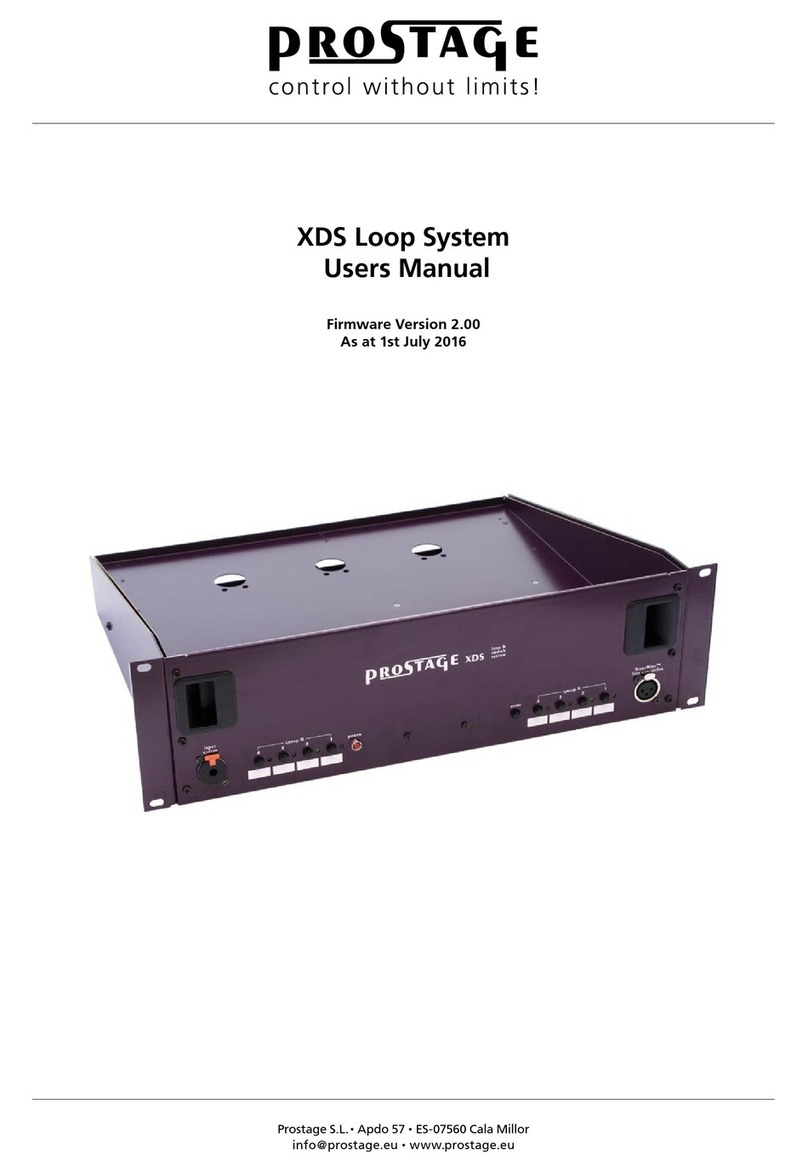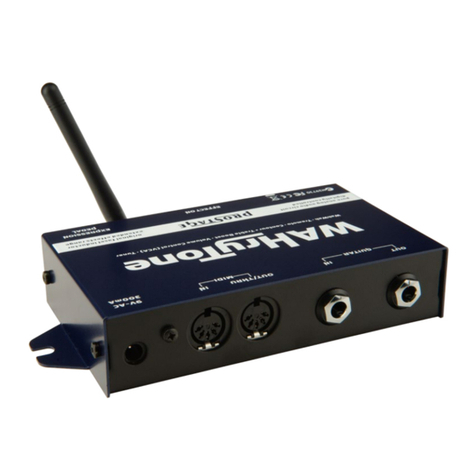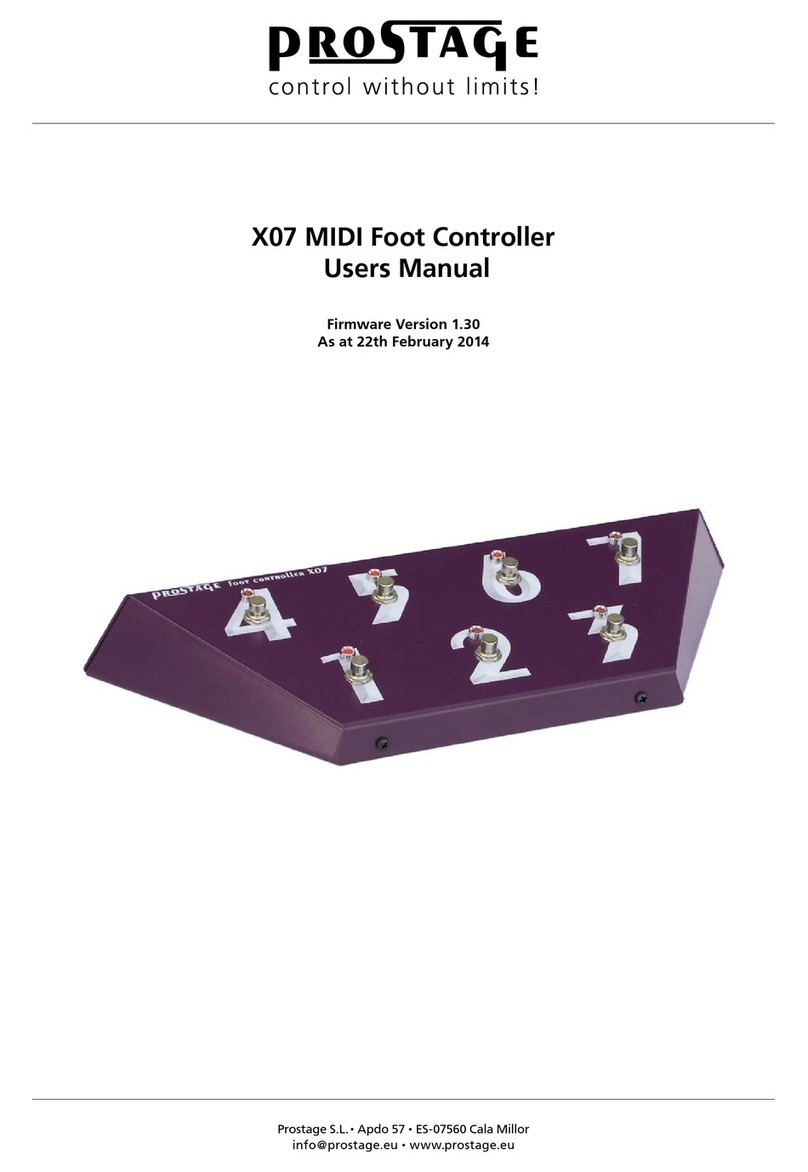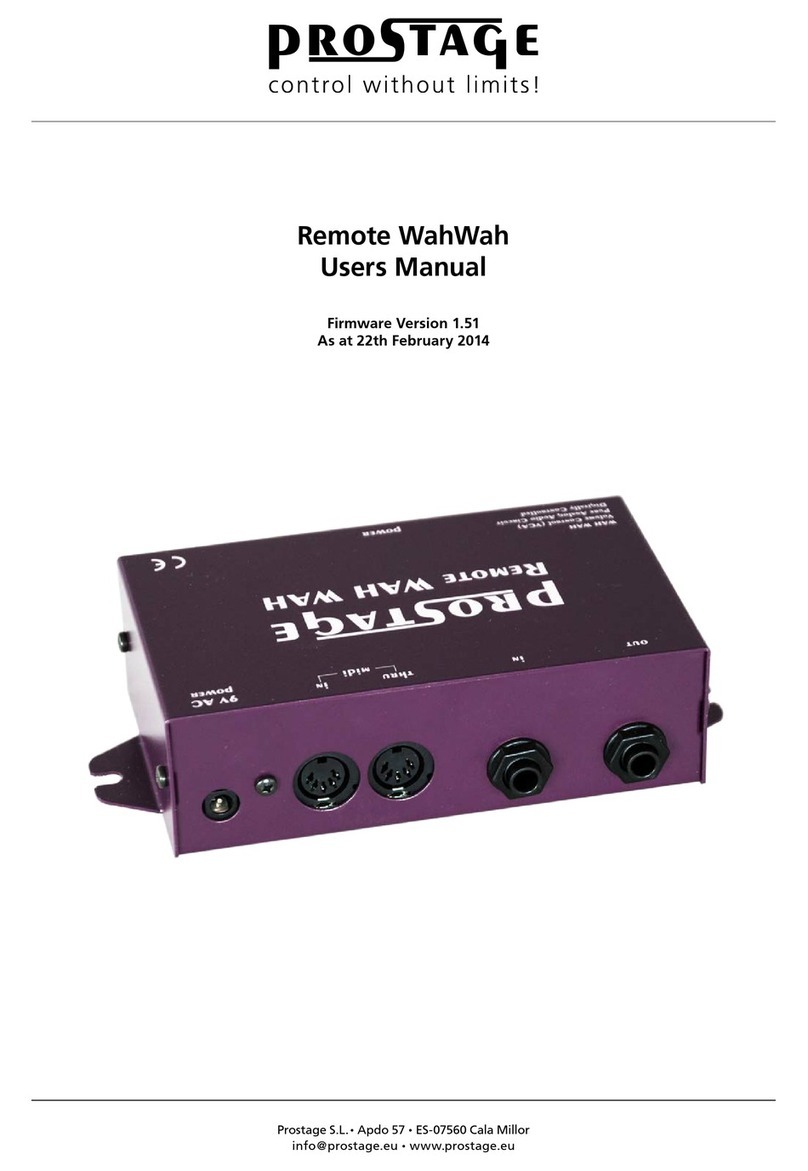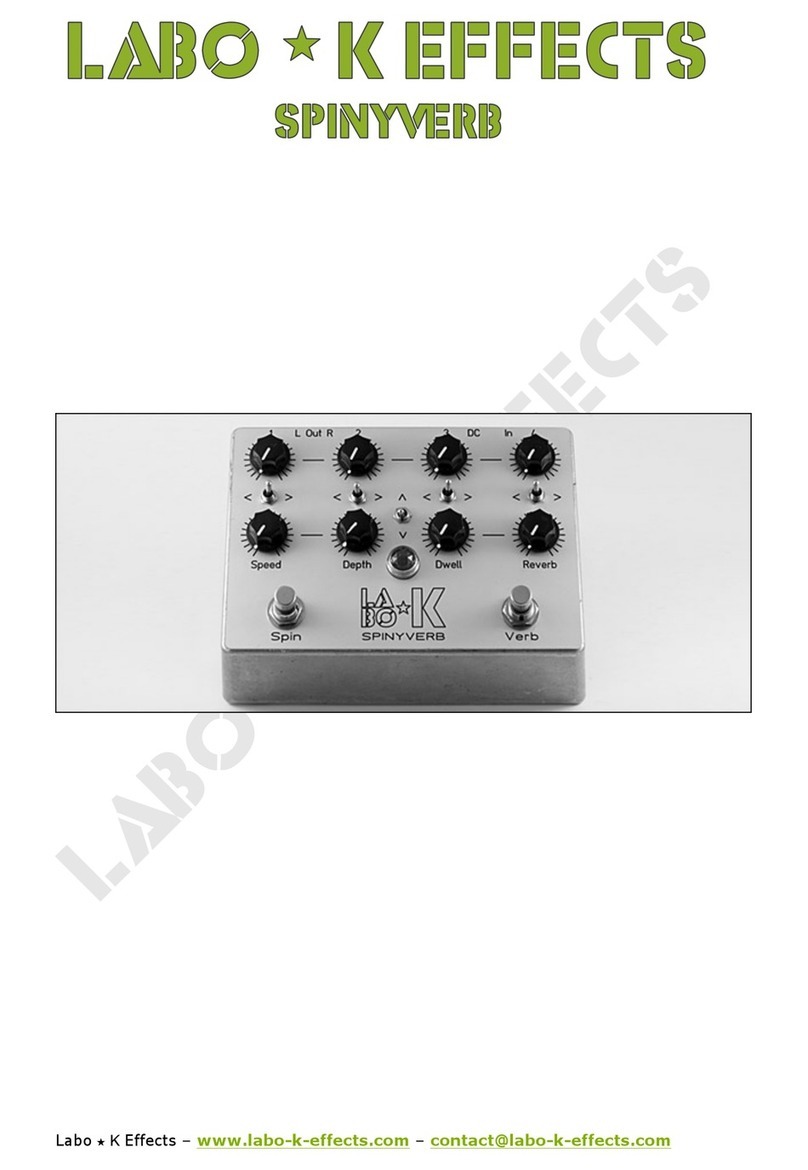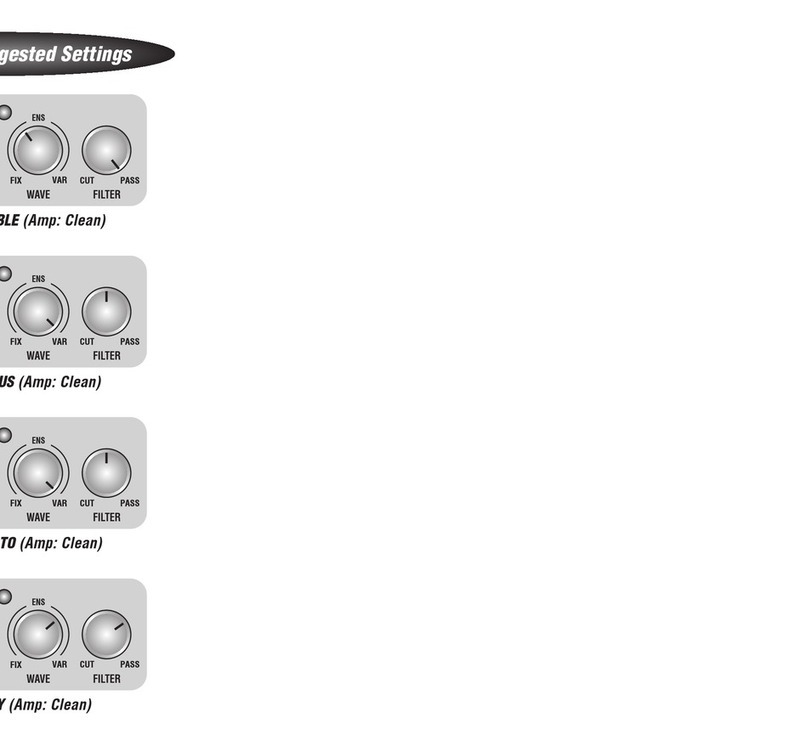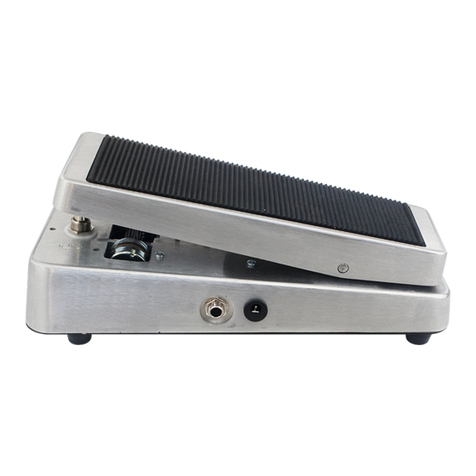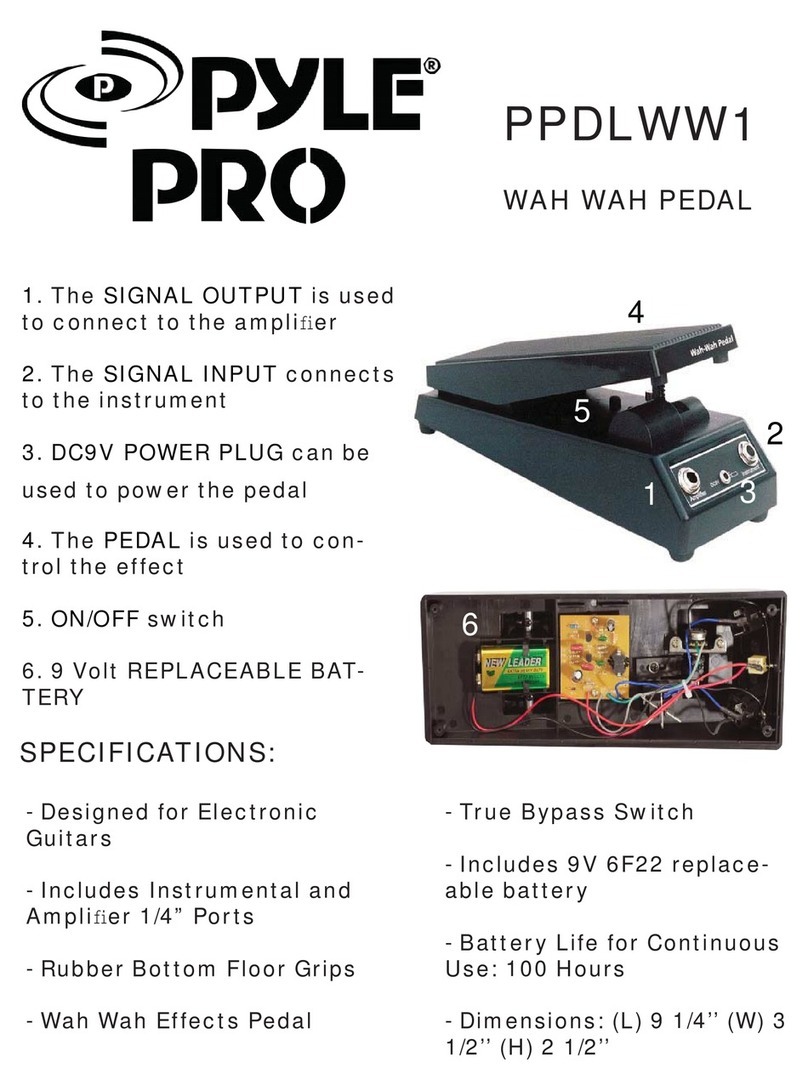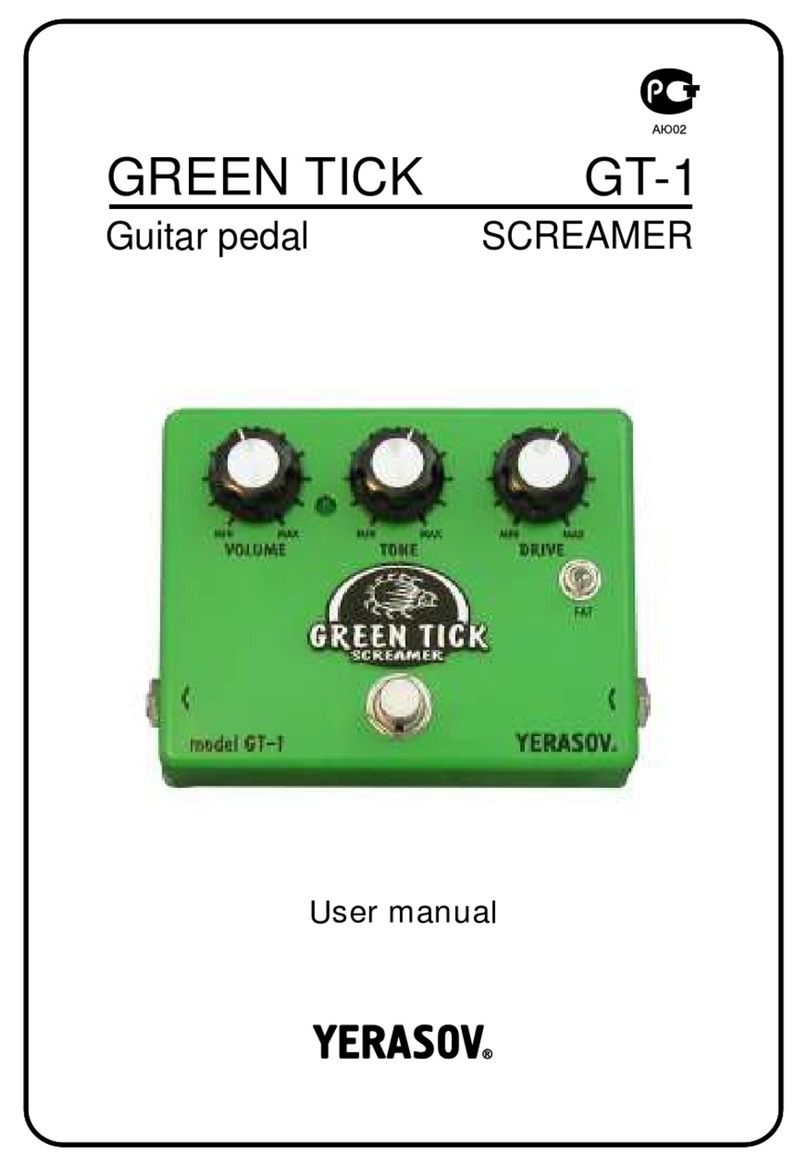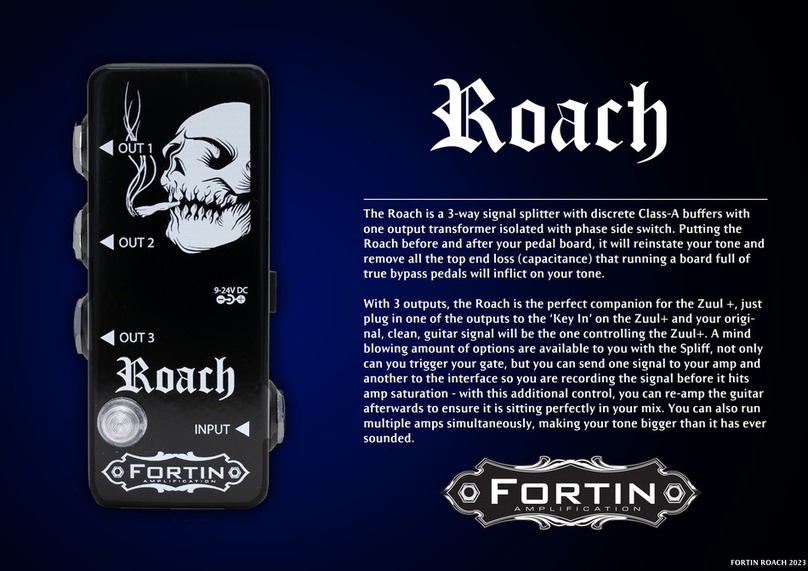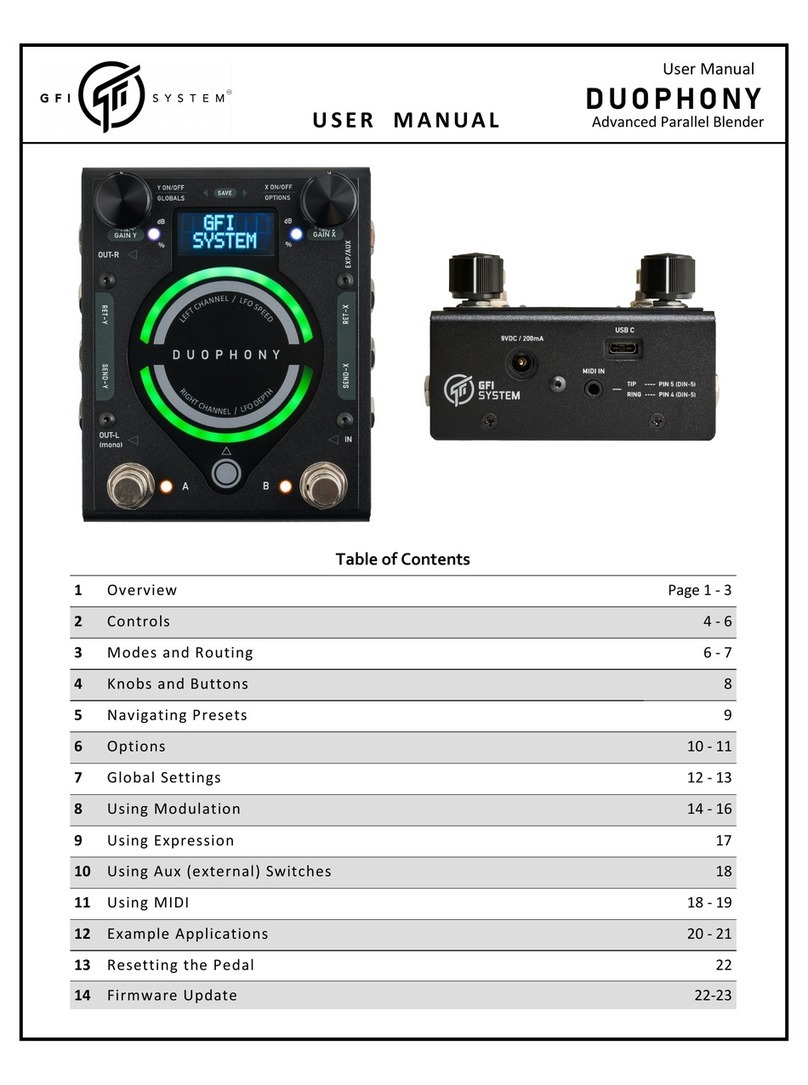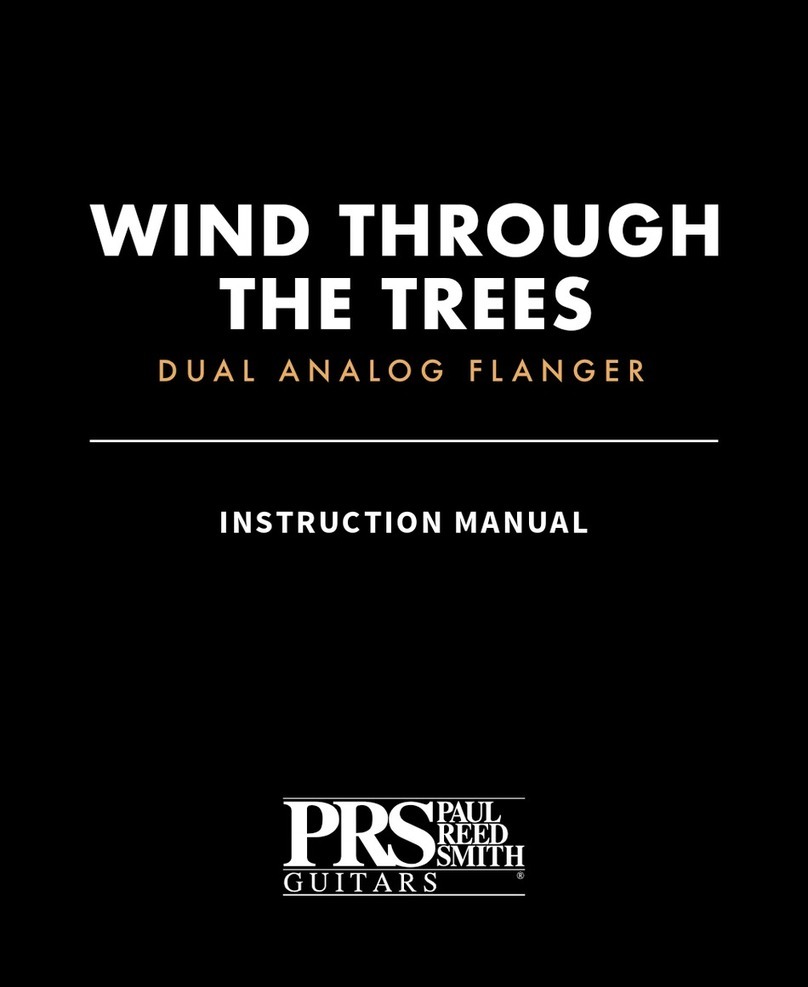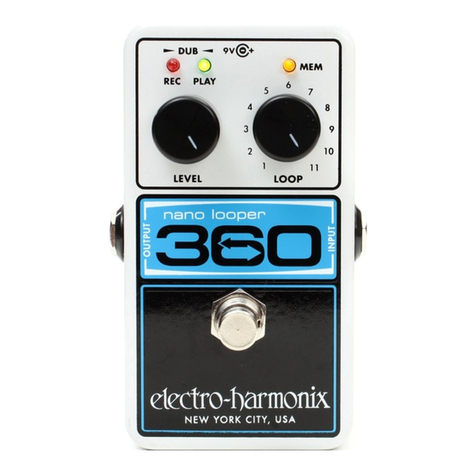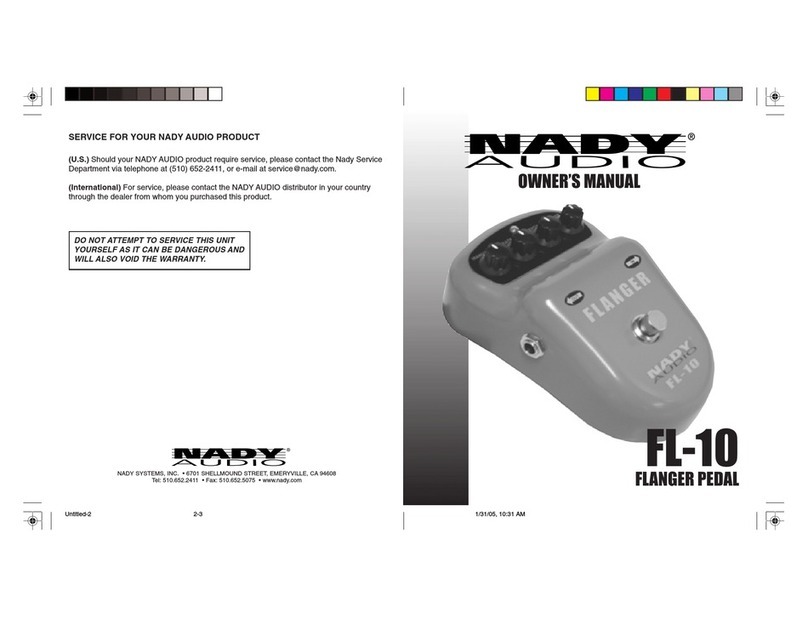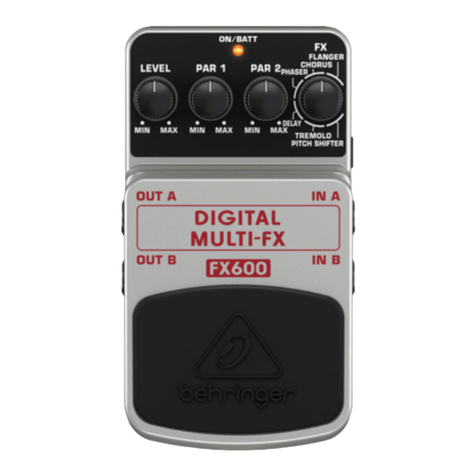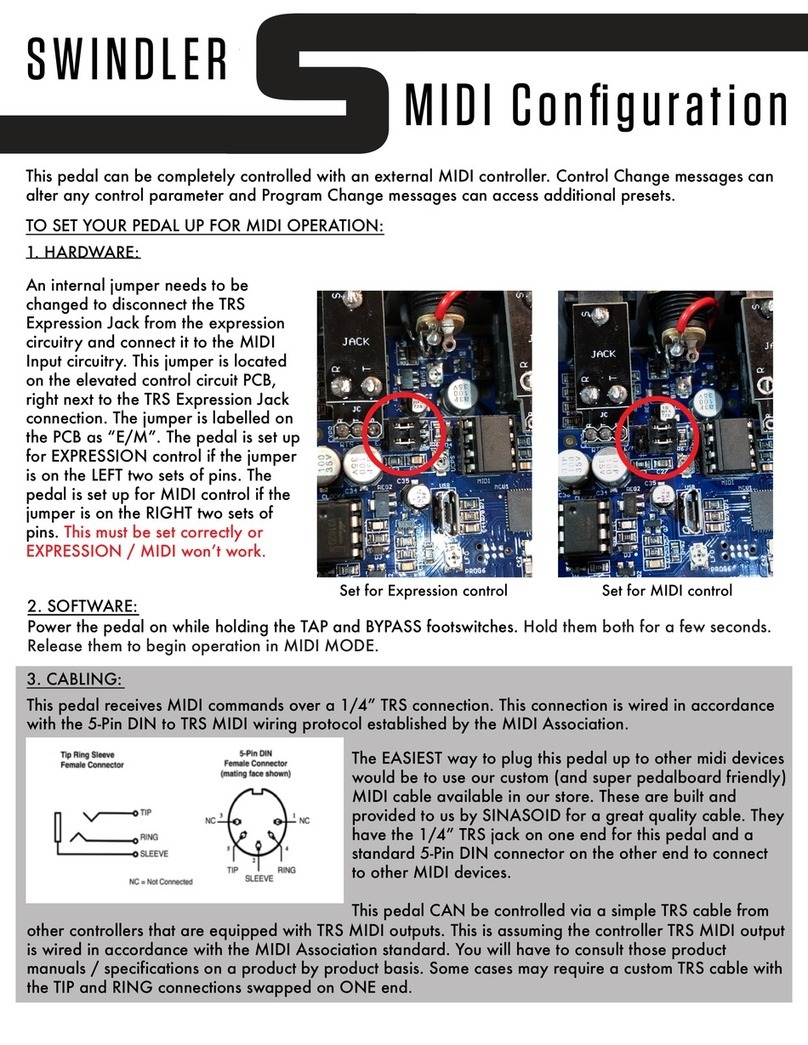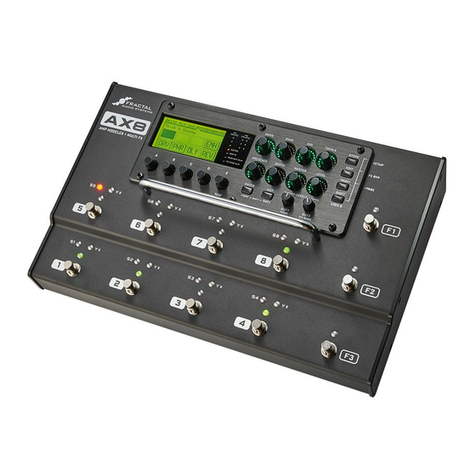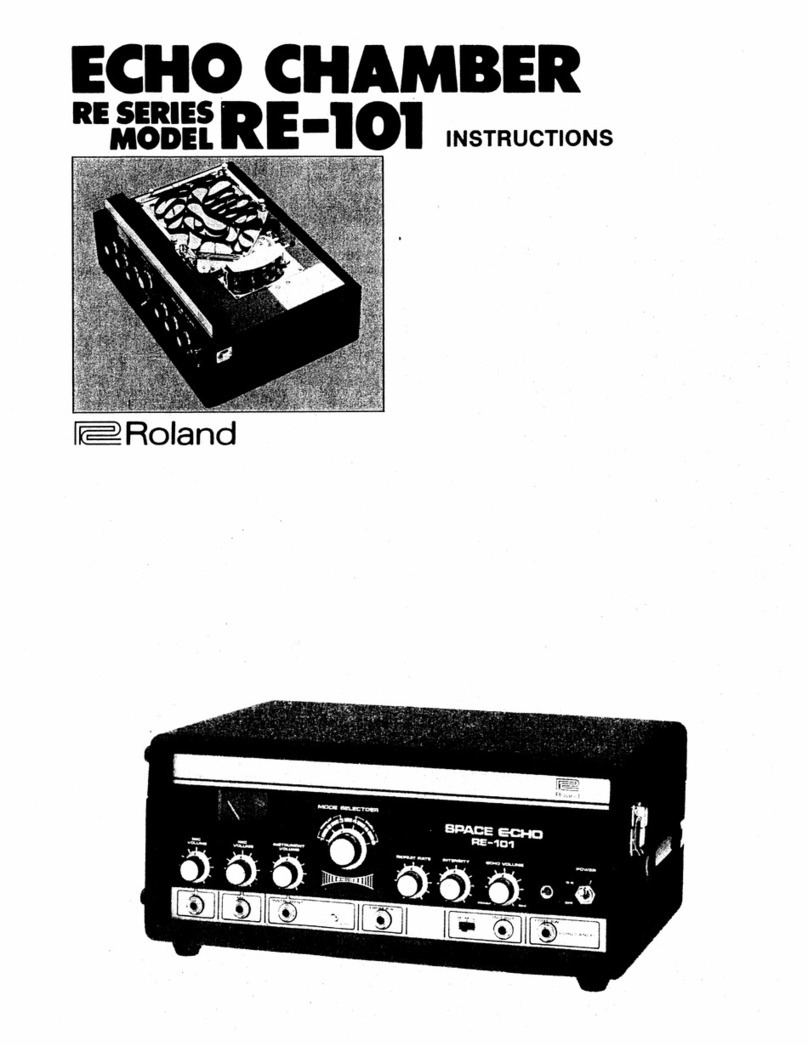Prostage Controller Pedal XCC BlackLine User manual


Controller Pedal XCC
General Information
What is MIDI?
MIDI stands for “Music Instrument Digital Interface”. MIDI is the global standard
for transmitting notes and control commands to and from all kinds of electronic
instruments and sound-processing equipment.
MIDI is a serial interface which only transmits control information - not audio
data - between music instruments and devices. For example, if you connect
a keyboard to a computer via MIDI, the computer, respectively the sequencer
software can play the keyboard. The sequencer tells the keyboard which sound
should be played with what velocity at what time. In other words, the computer
is practically pressing the keys. The sound is not transmitted by MIDI, but is
formed by the keyboard. It is also possible, of course, to connect several devices
together.
Besides notes, MIDI can transmit all kinds of control commands. For example,
the Sequencer tells the keyboard what volume the subsequent notes should be
played at. To this end, the sequencer sends Control Change command #7 with
the value of the level (1-127).
Using these Control Change commands, the value of numerous parameters can
be changed in realtime. The Prostage Controller Pedal XCC does nothing else
than transmit these Control Change commands. Thus, you can e.g. control a
WhaWha effect, the mix of the effect or the level of the unit you control.

*
Controller Pedal XCC
Users Manual
1. Connection of the Controller Pedal XCC
The Prostage™ MIDI equipment is interconnected using standard microphone
cables (not supplied). You can use any microphone cable available on the market.
If you choose quality cables, then cable lengths of up to 100m work troublefree.
Also tramsmission over a single-shielded multicore is no problem. The micro-
phone cable not only transmits the MIDI signal but supplies the Controller Pedal
with power as well. You do not require a separate power supply for the XCC. It
can be used “stand alone” or be connected to a Prostage Foot Controller. The
microphone cable can be extended as required. Important: Make sure the micro-
phone cables are wired correctly. The Prostage equipment does not work with
cables that are wired phase reversed (microphones still work with these cables).
2. Connection of the XTM Adaptor
Connect an AC power adaptor to the power input (labled AC or DC In) of the
XTM adaptor. You can use any power supply unit with 9-12 V AC or DC output.
The power supply must supply at least 20mA per connected Controller XCC.
Connect the MIDI Out of the XTM adaptor to the MIDI In of your equipment
using a standard MIDI cable. Connect your Controller pedal using a microphone
cable to the XTM adaptor.
Note:
The Y-adaptor cable and the
cable marked with * are only
required to allow the signal
lamps (LED’s) of Controller #1 to
follow Controller #2. Switching
works without this connection.

3. Function of the Controller Pedal XCC
Everytime you move (tilt) the Controller Pedal XCC, it sends a Control Change,
Pitch Bend or Aftertouch value (the actual position of the Pedal). The following
chapter describes which command is sendt in detail:
4. Settings of the Controller Pedal XCC
Inside the Controller Pedal there are dip-switches which allow you to set the
functionality of your XCC. Caution: Take care when you open the housing of the
Controller Pedal: do not tear off the wires connected to the XLR connectors! We
recommend to have this work carried out by a (guitar) technician. Some settings
only become operational after the power has been turned off and on again. Fol-
lowing settings can be chosen:
Decoder PCB (movement detector)
Switch 1-4 Chooses the MIDI transmit channel as listed below.
MIDI CH Switch1 Switch 2 Switch 3 Switch 4
1 OFF OFF OFF OFF
2 ON OFF OFF OFF
3 OFF ON OFF OFF
4 ON ON OFF OFF
5 OFF OFF ON OFF
6 ON OFF ON OFF
7 OFF ON ON OFF
8 ON ON ON OFF
9 OFF OFF OFF ON
10 ON OFF OFF ON
11 OFF ON OFF ON
12 ON ON OFF ON
13 OFF OFF ON ON
14 ON OFF ON ON
15 OFF ON ON ON
16 ON ON ON ON

Main PCB
Switch 1-7 Chooses the commands to be sent. (see 4.1 and 4.2)
Switch 8 Chooses between Control Change / Aftertouch or Pitch Bend
OFF = The Pedal sends Control Change commands according to
the table on pages 6-9. If Control Change number 120-127
is selected, the Pedal sends monophone aftertouch.
ON = The Pedal sends Pitch Bend according to table on page 10.
Jumper Chooses the working direction of the Pedal
OFF = Pedal down => hi value (127)
Pedal up => low value (0)
ON = Pedal down => low value (0)
Pedal up => hi value (127)
=> Default setting is “Volume” (Controller # 7) sent on MIDI channel 1.
4.1 Operating mode “Control Change / Aftertouch”
If DIP-switch 8 is set to “OFF”, the Controller Pedal XCC sends Control Change
commands according to the table on the following 4 pages. If you set a Con-
troller number between 120 and 127, the XCC sends monophone Aftertouch
instead of Control Change commands.
Switch 1-7 Chooses the Controller number according to the following list:
8 DIP switches
on the Main PCB
4 DIP switches on
the Decoder PCB
Jumper

Controller Nr.
DIP-Switch
1 2 3 4 5 6 7
Bank Select 0 OFF OFF OFF OFF OFF OFF OFF
Modulation Wheel 1 ON OFF OFF OFF OFF OFF OFF
Breath Controller 2 OFF ON OFF OFF OFF OFF OFF
not dened 3 ON ON OFF OFF OFF OFF OFF
Foot Controller 4 OFF OFF ON OFF OFF OFF OFF
Portamento Time 5 ON OFF ON OFF OFF OFF OFF
Data Entry 6 OFF ON ON OFF OFF OFF OFF
Main Volume 7 ON ON ON OFF OFF OFF OFF
Balance 8 OFF OFF OFF ON OFF OFF OFF
not dened 9 ON OFF OFF ON OFF OFF OFF
Panorama 10 OFF ON OFF ON OFF OFF OFF
Expression Contr. 11 ON ON OFF ON OFF OFF OFF
Control 1 12 OFF OFF ON ON OFF OFF OFF
Control 2 13 ON OFF ON ON OFF OFF OFF
not dened 14 OFF ON ON ON OFF OFF OFF
not dened 15 ON ON ON ON OFF OFF OFF
General Purpose 1 16 OFF OFF OFF OFF ON OFF OFF
General Purpose 2 17 ON OFF OFF OFF ON OFF OFF
General Purpose 3 18 OFF ON OFF OFF ON OFF OFF
General Purpose 4 19 ON ON OFF OFF ON OFF OFF
not dened 20 OFF OFF ON OFF ON OFF OFF
not dened 21 ON OFF ON OFF ON OFF OFF
not dened 22 OFF ON ON OFF ON OFF OFF
not dened 23 ON ON ON OFF ON OFF OFF
not dened 24 OFF OFF OFF ON ON OFF OFF
not dened 25 ON OFF OFF ON ON OFF OFF
not dened 26 OFF ON OFF ON ON OFF OFF
not dened 27 ON ON OFF ON ON OFF OFF
not dened 28 OFF OFF ON ON ON OFF OFF
not dened 29 ON OFF ON ON ON OFF OFF
not dened 30 OFF ON ON ON ON OFF OFF
not dened 31 ON ON ON ON ON OFF OFF

Controller Nr.
DIP-Switch
1 2 3 4 5 6 7
LSB Controller #0 32 OFF OFF OFF OFF OFF ON OFF
LSB Controller #1 33 ON OFF OFF OFF OFF ON OFF
LSB Controller #2 34 OFF ON OFF OFF OFF ON OFF
LSB Controller #3 35 ON ON OFF OFF OFF ON OFF
LSB Controller #4 36 OFF OFF ON OFF OFF ON OFF
LSB Controller #5 37 ON OFF ON OFF OFF ON OFF
LSB Controller #6 38 OFF ON ON OFF OFF ON OFF
LSB Controller #7 39 ON ON ON OFF OFF ON OFF
LSB Controller #8 40 OFF OFF OFF ON OFF ON OFF
LSB Controller #9 41 ON OFF OFF ON OFF ON OFF
LSB Controller #10 42 OFF ON OFF ON OFF ON OFF
LSB Controller #11 43 ON ON OFF ON OFF ON OFF
LSB Controller #12 44 OFF OFF ON ON OFF ON OFF
LSB Controller #13 45 ON OFF ON ON OFF ON OFF
LSB Controller #14 46 OFF ON ON ON OFF ON OFF
LSB Controller #15 47 ON ON ON ON OFF ON OFF
LSB Controller #16 48 OFF OFF OFF OFF ON ON OFF
LSB Controller #17 49 ON OFF OFF OFF ON ON OFF
LSB Controller #18 50 OFF ON OFF OFF ON ON OFF
LSB Controller #19 51 ON ON OFF OFF ON ON OFF
LSB Controller #20 52 OFF OFF ON OFF ON ON OFF
LSB Controller #21 53 ON OFF ON OFF ON ON OFF
LSB Controller #22 54 OFF ON ON OFF ON ON OFF
LSB Controller #23 55 ON ON ON OFF ON ON OFF
LSB Controller #24 56 OFF OFF OFF ON ON ON OFF
LSB Controller #25 57 ON OFF OFF ON ON ON OFF
LSB Controller #26 58 OFF ON OFF ON ON ON OFF
LSB Controller #27 59 ON ON OFF ON ON ON OFF
LSB Controller #28 60 OFF OFF ON ON ON ON OFF
LSB Controller #29 61 ON OFF ON ON ON ON OFF
LSB Controller #30 62 OFF ON ON ON ON ON OFF
LSB Controller #31 63 ON ON ON ON ON ON OFF

Controller Nr.
DIP-Switch
1 2 3 4 5 6 7
Sustain Pedal 64 OFF OFF OFF OFF OFF OFF ON
Portamento ON/OFF 65 ON OFF OFF OFF OFF OFF ON
Sostenuto 66 OFF ON OFF OFF OFF OFF ON
Soft Pedal 67 ON ON OFF OFF OFF OFF ON
Legato Footswitch 68 OFF OFF ON OFF OFF OFF ON
Hold 2 69 ON OFF ON OFF OFF OFF ON
Sound Variation 70 OFF ON ON OFF OFF OFF ON
Harmonic Content 71 ON ON ON OFF OFF OFF ON
Release Time 72 OFF OFF OFF ON OFF OFF ON
Attack Time 73 ON OFF OFF ON OFF OFF ON
Brightness 74 OFF ON OFF ON OFF OFF ON
Sound Contr. #6 75 ON ON OFF ON OFF OFF ON
Sound Contr. #7 76 OFF OFF ON ON OFF OFF ON
Sound Contr. #8 77 ON OFF ON ON OFF OFF ON
Sound Contr. #9 78 OFF ON ON ON OFF OFF ON
Sound Contr. #10 79 ON ON ON ON OFF OFF ON
General Purpose 5 80 OFF OFF OFF OFF ON OFF ON
General Purpose 6 81 ON OFF OFF OFF ON OFF ON
General Purpose 7 82 OFF ON OFF OFF ON OFF ON
General Purpose 8 83 ON ON OFF OFF ON OFF ON
not dened 84 OFF OFF ON OFF ON OFF ON
not dened 85 ON OFF ON OFF ON OFF ON
not dened 86 OFF ON ON OFF ON OFF ON
not dened 87 ON ON ON OFF ON OFF ON
not dened 88 OFF OFF OFF ON ON OFF ON
not dened 89 ON OFF OFF ON ON OFF ON
not dened 90 OFF ON OFF ON ON OFF ON
Reverb Depth 91 ON ON OFF ON ON OFF ON
Tremolo Depth 92 OFF OFF ON ON ON OFF ON
Chorus Depth 93 ON OFF ON ON ON OFF ON
Detune Depth 94 OFF ON ON ON ON OFF ON
Phaser Depth 95 ON ON ON ON ON OFF ON

Controller Nr.
DIP-Switch
1 2 3 4 5 6 7
Data Increment 96 OFF OFF OFF OFF OFF ON ON
Data Decrement 97 ON OFF OFF OFF OFF ON ON
Non-Reg. LSB 98 OFF ON OFF OFF OFF ON ON
Non-Reg. MSB 99 ON ON OFF OFF OFF ON ON
Reg. Para. LSB 100 OFF OFF ON OFF OFF ON ON
Reg. Para. MSB 101 ON OFF ON OFF OFF ON ON
not dened 102 OFF ON ON OFF OFF ON ON
not dened 103 ON ON ON OFF OFF ON ON
not dened 104 OFF OFF OFF ON OFF ON ON
not dened 105 ON OFF OFF ON OFF ON ON
not dened 106 OFF ON OFF ON OFF ON ON
not dened 107 ON ON OFF ON OFF ON ON
not dened 108 OFF OFF ON ON OFF ON ON
not dened 109 ON OFF ON ON OFF ON ON
not dened 110 OFF ON ON ON OFF ON ON
not dened 111 ON ON ON ON OFF ON ON
not dened 112 OFF OFF OFF OFF ON ON ON
not dened 113 ON OFF OFF OFF ON ON ON
not dened 114 OFF ON OFF OFF ON ON ON
not dened 115 ON ON OFF OFF ON ON ON
not dened 116 OFF OFF ON OFF ON ON ON
not dened 117 ON OFF ON OFF ON ON ON
not dened 118 OFF ON ON OFF ON ON ON
not dened 119 ON ON ON OFF ON ON ON
Aftertouch (mono) 120 OFF OFF OFF ON ON ON ON
Aftertouch (mono) 121 ON OFF OFF ON ON ON ON
Aftertouch (mono) 122 OFF ON OFF ON ON ON ON
Aftertouch (mono) 123 ON ON OFF ON ON ON ON
Aftertouch (mono) 124 OFF OFF ON ON ON ON ON
Aftertouch (mono) 125 ON OFF ON ON ON ON ON
Aftertouch (mono) 126 OFF ON ON ON ON ON ON
Aftertouch (mono) 127 ON ON ON ON ON ON ON

semitone
steps Switch 1 Switch 2 Switch 3 Switch 4
minor 2nd 1 OFF OFF OFF OFF
major 2nd 2 ON OFF OFF OFF
minor 3rd 3 OFF ON OFF OFF
major 3rd 4 ON ON OFF OFF
perfect 4th 5 OFF OFF ON OFF
diminished 5th 6 ON OFF ON OFF
perfect 5th 7 OFF ON ON OFF
minor 6th 8 ON ON ON OFF
major 6th 9 OFF OFF OFF ON
minor 7th 10 ON OFF OFF ON
major 7th 11 OFF ON OFF ON
octave 12 ON ON OFF ON
12 OFF OFF ON ON
12 ON OFF ON ON
12 OFF ON ON ON
2 octaves 24 ON ON ON ON
Switch 5 Chooses the working direction of the Pedal
OFF = Pedal down => Pitch max.
Pedal up => Pitch 0
ON= Pedal down => Pitch 0
Pedal up => Pitch max.
Switch 6 Chooses the direction of pitch
OFF = Pitch down
ON = Pitch up
Switch 7 Chooses the resolution of pitch
OFF = semi-tone steps
ON = ne (100/125 steps)
4.2 Operation mode “Pitch Bend”
If DIP-Switch 8 (see page 5) is set to “ON”, the Pedal sends Pitch Bend according
to the following list:
Switch 1-4 Chooses the range of pitch.

5. Warranty / Support
The Controller Pedal XCC is covered by a 2-year warranty. Prostage shall not be
liable if the damage was caused by inappropriate use or if the Controller Pedal
was connected to anything else than the XTM / XTMpro adaptor or a device with
a Prostage compatible Foot Controller connector. The detailed terms of the war-
ranty can be downloaded from the Prostage website.
If you need technical support, please contact your local dealer or email to
Software Version 1.71, © Prostage™, 05/2007

Other Prostage Music Pedal manuals
